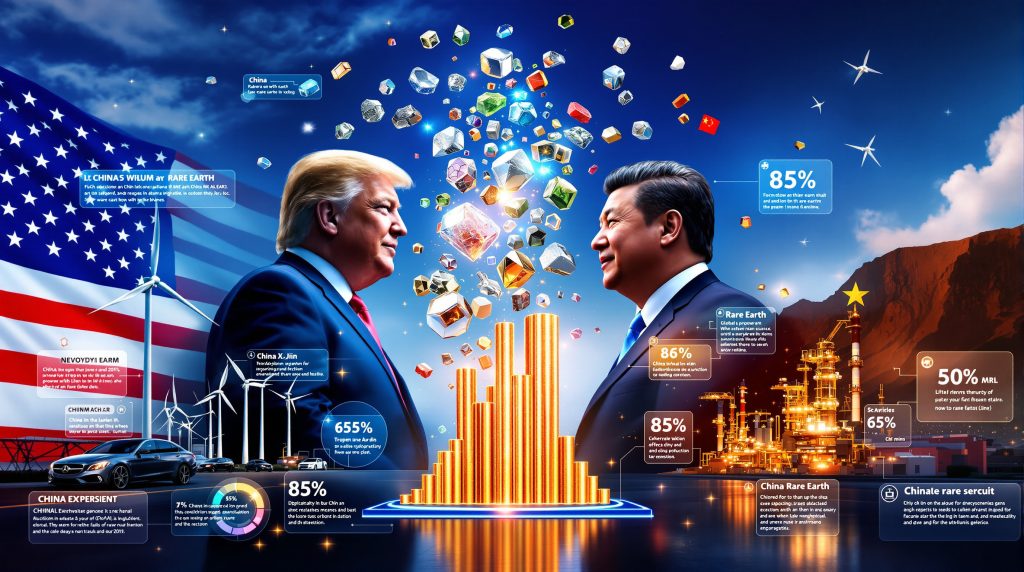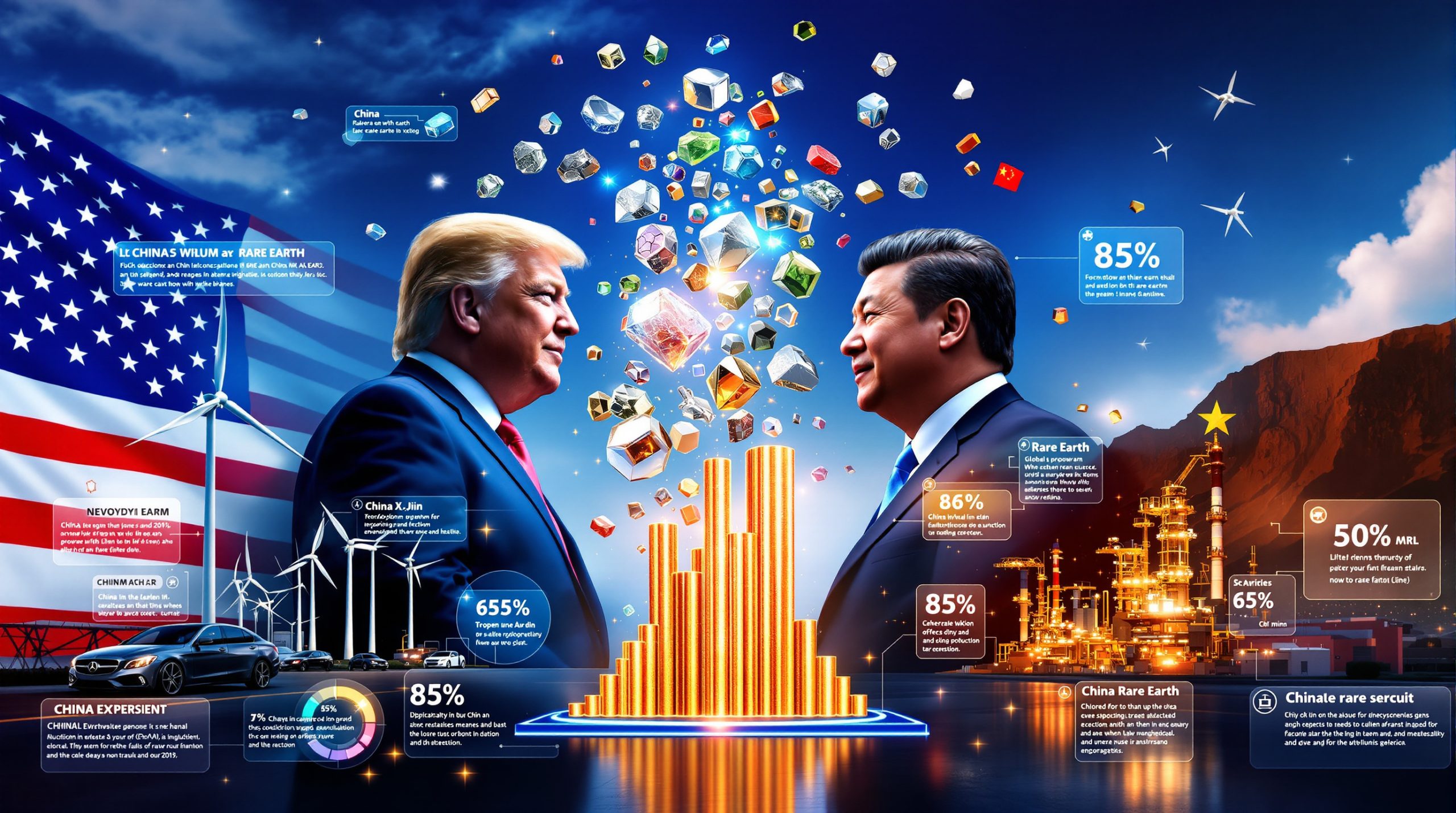Strategic Minerals at the Center of Global Trade Tensions
The United States and China find themselves navigating one of their most complex trade negotiations in recent years, centered on access to rare earth elements that power everything from smartphones to advanced military systems. Treasury Secretary Scott Bessent's recent comments suggesting a China rare earths deal could be completed by Thanksgiving 2025 highlight both the urgency and complexity surrounding these critical materials.
This negotiation represents far more than a typical trade dispute. Rare earth elements serve as the invisible foundation of modern technology, enabling the miniaturisation and enhanced performance that consumers expect from electronic devices whilst supporting national defence capabilities that governments consider essential to security.
Understanding the Critical Role of Rare Earth Elements
Rare earth elements encompass 17 metallic elements that, despite their name, are relatively abundant in Earth's crust. The challenge lies not in their scarcity but in the complex, environmentally intensive processes required to extract and separate them into commercially viable forms. Furthermore, rare earth reserves distribution across different countries creates additional geopolitical complexities.
Key Industrial Applications:
• Permanent magnets: Neodymium-iron-boron magnets power electric vehicle motors and wind turbine generators, with dysprosium and terbium additions enabling high-temperature performance
• Catalytic processes: Cerium compounds serve as essential catalysts in petroleum refining and automotive catalytic converters
• Display technologies: Europium and yttrium enable the phosphors that create colours in LED lighting and electronic displays
• Advanced ceramics: Yttrium-aluminium-garnet finds critical applications in aerospace and laser technologies
• Defence systems: Samarium-cobalt magnets provide the precision control needed for guided munitions and radar systems
The technological dependence on these materials creates vulnerabilities that extend beyond simple supply chain concerns. Electric vehicles typically require 10-15 kilograms of rare earth magnets per vehicle, whilst a single wind turbine may contain 200-600 kilograms of rare earth materials depending on its design and capacity. Moreover, the energy transition minerals sector continues expanding rapidly, increasing demand pressures.
Current Diplomatic Framework and Timeline Pressures
Following high-level discussions between Presidents Trump and Xi Jinping in South Korea, both nations established a preliminary framework addressing their immediate concerns. The United States committed to suspending planned 100% tariffs on Chinese imports, whilst China agreed to hold off on implementing new export licensing requirements during the negotiation period.
Treasury Secretary Bessent's optimistic timeline reflects administration confidence in reaching comprehensive terms, though he notably used conditional language, stating the deal would "hopefully" be completed by Thanksgiving 2025. This diplomatic hedging suggests awareness of the technical complexities involved in crafting agreements that address both nations' strategic concerns whilst maintaining global supply chain stability.
The framework emerged from recognition that punitive measures alone would likely disrupt global manufacturing without providing sustainable solutions. China's dominant position in rare earth processing creates dependencies that cannot be quickly eliminated through alternative sourcing, making diplomatic engagement the most practical short-term approach.
China's Strategic Position and Export Control Evolution
China's leverage in these negotiations stems from decades of investment in integrated rare earth operations, from mining through final product manufacturing. The nation controls approximately 85-90% of global rare earth processing capacity, a dominance that reflects both natural resource advantages and sustained technological development rather than simple market manipulation.
This processing monopoly creates significant barriers for nations seeking supply diversification. Additionally, the US-China trade impact extends beyond rare earths, affecting multiple strategic sectors simultaneously.
China's approach to export controls has evolved progressively, beginning with restrictions on technology exports in December 2023 and expanding to encompass broader licensing requirements. The nation's willingness to use rare earth access as diplomatic leverage became evident during the 2010-2011 period, when export quota reductions caused global prices to increase dramatically.
Historical Context of Supply Disruptions:
| Period | Action Taken | Market Impact |
|---|---|---|
| 2010-2011 | Export quota reductions (30-37% cuts) | Dysprosium prices increased 15-fold |
| December 2023 | Technology export restrictions | Limited immediate price impact |
| October 2025 | Licensing system discussions | Ongoing price volatility |
Economic Implications Beyond Simple Trade Metrics
The rare earth negotiations expose fundamental vulnerabilities in Western supply chains that extend beyond immediate material access concerns. Industries that have optimised their operations around Chinese supply chains face significant switching costs and technical barriers when considering alternative suppliers.
Supply Chain Vulnerability Assessment:
The integrated nature of Chinese rare earth operations creates dependencies that cannot be easily replicated elsewhere. However, the defence minerals supply chain faces particular vulnerabilities that require strategic attention.
Industry-Specific Risk Profiles:
• Electric vehicle manufacturers: High exposure due to significant neodymium magnet requirements (10-15 kg per vehicle) and limited alternative magnet technologies
• Wind energy sector: Critical dependence on dysprosium and terbium for direct-drive generator magnets, with 200-600 kg required per megawatt of capacity
• Electronics manufacturers: Moderate exposure through display phosphors and miniaturised components, but broader supplier base available
• Defence contractors: Severe exposure for precision-guided systems requiring specialised rare earth alloys with limited commercial alternatives
Strategic Leverage and Negotiating Positions
China's negotiating advantages extend beyond simple market share statistics. The nation's integrated supply chain model, where mining, processing, alloy production, and magnet manufacturing occur within coordinated operations, creates switching costs that cannot be easily overcome through policy directives or financial incentives alone.
China's Key Advantages:
- Technological expertise: Decades of accumulated knowledge in complex separation processes
- Infrastructure integration: Established transportation and processing networks optimised for efficiency
- Manufacturing relationships: Direct connections with global technology manufacturers
- Cost competitiveness: Scale advantages and integrated operations providing pricing flexibility
The United States' response strategy combines immediate diplomatic engagement with longer-term infrastructure development initiatives. Nevertheless, the mining industry evolution suggests that establishing comparable capabilities requires substantial time and investment.
US Strategic Options:
• Domestic capacity building: Investment in separation and processing facilities, though constrained by environmental regulations and technical expertise gaps
• Allied partnerships: Coordination with Australia, Canada, and European nations to develop alternative supply chains
• Technology development: Research funding for alternative materials and recycling technologies to reduce dependence
• Strategic reserves: Accumulation of critical materials inventory to provide buffer during supply disruptions
Potential Agreement Framework and Success Metrics
A successful China rare earths deal would likely address both nations' core concerns whilst establishing mechanisms for managing future disputes. For the United States, key priorities include guaranteed access to defence-critical materials, predictable pricing mechanisms, and sufficient transition time to develop alternative supply sources.
China's objectives focus on maintaining market access without facing punitive trade measures, securing recognition of its technological leadership, and preserving flexibility in export control implementation. According to recent analysis by the Lowy Institute, "the contest over critical minerals represents a new permanent feature of strategic competition".
Potential Agreement Elements:
• Supply guarantees: Minimum quantities assured for critical applications, particularly defence-related uses
• Price stabilisation: Mechanisms to prevent extreme volatility whilst allowing market-based pricing
• Technology cooperation: Limited sharing of processing knowledge in exchange for market access commitments
• Dispute resolution: Formal procedures for addressing conflicts over export restrictions or trade barriers
Technical Complexities and Implementation Challenges
The Thanksgiving timeline faces significant technical hurdles beyond diplomatic considerations. Comprehensive trade agreements involving strategic materials typically require extensive technical negotiations covering material classifications, quality standards, testing procedures, and compliance monitoring systems.
Both nations must align their regulatory frameworks, a process complicated by different legal systems and administrative procedures. As Reuters reported, the negotiations involve "complex technical discussions that could extend beyond the initial timeline".
Critical Implementation Factors:
• Material specifications: Precise definitions of controlled substances, including trace amounts and processed forms
• Quality standards: Testing protocols and certification procedures for exported materials
• Emergency provisions: Procedures for addressing sudden supply disruptions or security concerns
• Monitoring mechanisms: Systems for verifying compliance and resolving disputes over implementation
Global Market Dynamics and Third-Party Implications
The bilateral negotiations will significantly impact other nations dependent on Chinese rare earth supplies. European Union countries, Japan, and South Korea face similar supply chain vulnerabilities but lack the diplomatic leverage of direct US-China negotiations.
Regional Response Strategies:
The European Union has accelerated implementation of its Critical Raw Materials Act, targeting reduced dependence on Chinese supplies through domestic processing capabilities and alternative supplier relationships. Japan and South Korea have increased investment in recycling technologies and regional cooperation initiatives, though both remain heavily dependent on Chinese processing capabilities.
Investment Implications:
Regardless of specific agreement terms, the negotiations signal broader changes in how nations approach critical material dependencies. Companies involved in rare earth mining outside China, processing technology development, and recycling operations may benefit from increased investment as nations seek supply diversification.
However, businesses heavily integrated with Chinese supply chains face uncertainty about future access terms and pricing stability. The manufacturing sector must balance the benefits of established relationships against the risks of supply disruption during future diplomatic tensions.
Risk Assessment and Alternative Scenarios
Should negotiations fail to produce comprehensive agreement by the stated deadline, both nations have outlined potential responses that could significantly disrupt global supply chains. The United States has maintained the option to implement previously threatened 100% tariffs, whilst China could proceed with comprehensive export licensing requirements.
Escalation Scenarios:
• US response options: Implementation of tariffs, acceleration of domestic production initiatives, enhanced partnerships with alternative suppliers, and strategic reserve deployment
• Chinese counter-measures: Full implementation of export controls, expansion of restricted materials lists, reduced cooperation on other trade issues, and enhanced relationships with non-Western partners
Market Preparation Strategies:
Industries dependent on rare earth materials are increasingly developing contingency plans including extended inventory holdings, supplier diversification initiatives, and alternative technology development programmes. However, the technical and economic barriers to rapid supply chain restructuring limit the effectiveness of short-term mitigation strategies.
Long-Term Strategic Implications
The China rare earths deal represents a test case for managing strategic resource dependencies in an increasingly competitive global environment. Success requires both nations to balance their legitimate strategic interests with the practical realities of integrated global supply chains.
The outcome will likely influence how other nations approach similar resource security challenges, particularly as clean energy transitions increase demand for critical materials. Countries with significant mineral resources may seek to develop their own processing capabilities, potentially reducing global supply chain concentration over time.
Future Market Evolution:
Technological development in recycling, alternative materials, and processing efficiency could gradually reduce dependence on primary rare earth production. However, these changes require years to decades for full implementation, making near-term diplomatic solutions essential for maintaining supply stability.
The negotiations also highlight the intersection between trade policy and national security planning. Future agreements may need to incorporate more sophisticated mechanisms for balancing commercial interests with security concerns, particularly as technological competition intensifies between major powers.
Balancing Competition and Cooperation
The complexity of rare earth negotiations reflects broader challenges in managing economic interdependence between strategic competitors. Whilst both nations seek to protect their respective interests, complete supply chain decoupling would impose significant costs on global manufacturers and consumers.
Success will ultimately depend on both nations' ability to establish sustainable frameworks for managing critical material dependencies whilst pursuing their respective strategic objectives. The outcome will provide important precedents for addressing similar resource security challenges in other sectors where technological advancement and geopolitical competition intersect.
The China rare earths deal serves as a microcosm of larger questions about how nations can maintain beneficial economic relationships whilst protecting their strategic autonomy in an interconnected but increasingly fragmented global economy. Consequently, the negotiations' outcome will influence global approaches to strategic resource management for years to come.
Looking to Navigate Critical Minerals Investment Opportunities?
Discovery Alert's proprietary Discovery IQ model delivers real-time alerts on significant mineral discoveries across critical materials sectors, helping investors identify actionable opportunities before broader market awareness develops. Explore why major mineral discoveries can generate substantial returns by visiting Discovery Alert's dedicated discoveries page and begin your 30-day free trial today to position yourself ahead of evolving market dynamics.




